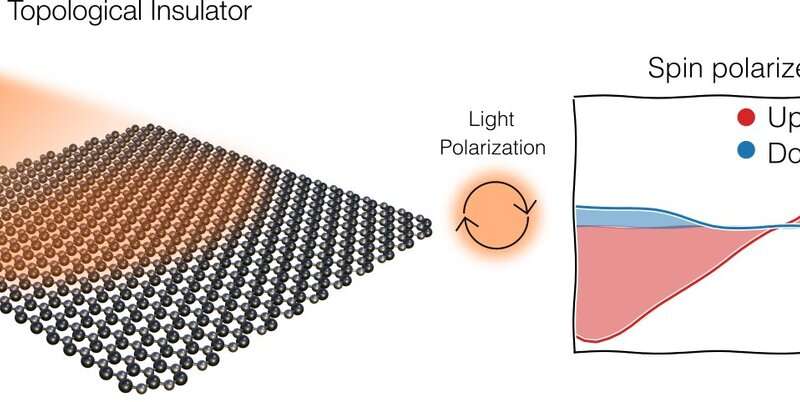Iluminating a control knob for topological insulators

Topological insulators are a new generation of materials bearing intriguing properties that might be instrumental for quantum computing and quantum information. Found in the lab for the first time in 2007, two-dimensional topological insulators have an insulating bulk bridged by topological edge states.
Unlike most electronic states in materials, which are fragile, topological states are robust against defects and other perturbations. One can think of these materials as a way to bring order to an otherwise chaotic rush-hour kind of traffic at the nanoscale. In this traffic analogy, non-topological states are a bumper car track where any kind of trajectory is allowed, while topological states resemble a one-way avenue where electrons march lockstep in one direction and can not turn around. But this featured robustness may also pose a problem for manipulating the topological states, as most perturbations will just not produce any sizable consequence. For example, placing suitable molecules on top of the materials to alter its properties, a strategy much used in surface science to tune the properties of a material such as surface functionalization, will not substantially modify the topological states.
Now, in our recent work we suggest that shining a laser on two-dimensional topological insulators such as germanene, silicene and others, might provide much-needed control. Besides their charge, electrons have a flavor called "spin" and sources of spin currents are highly sought. Our work points to a way to obtain a tunable source of such currents based on the manipulation of the topological states in these materials.
Although light is most often used as a tool to observe rather than change a material, previous work has shown a way to alter the properties of a material by using light: introducing laser-induced bandgaps and even changing the topological properties. Generically, this strategy is referred to as Floquet engineering and is pushing the frontiers of materials science to situations out of equilibrium (as one is feeding energy constantly through a laser).
In an article featured in Nano Letters, we propose an incarnation of Floquet engineering, where light is used to gently disrupt the topological states. Thanks to symmetry-crafted selection rules tailor-made to produce the desired outcome, we show that changing the laser polarization allows for almost perfectly spin-polarized photocurrents. Such special current sources are much sought for spin-based quantum devices seeking to exploit entanglement for the second quantum revolution.
This story is part of Science X Dialog, where researchers can report findings from their published research articles. Visit this page for information about Science X Dialog and how to participate.
More information: Matías Berdakin et al. Spin-Polarized Tunable Photocurrents, Nano Letters (2021). DOI: 10.1021/acs.nanolett.1c00420
Bios:
M.B: I have a Ph.D. in Chemistry from Universidad Nacional de Cordoba (UNC). During my career, I have worked on experimental and theoretical aspects of light-induced phenomena. Currently, I'm am an assistant researcher at the National Council for Scientific and Technical Research (CONICET, Argentina) and an assistant professor at the School of Chemistry of UNC.
EARM: I am a Ph.D. candidate at Universidad de Chile. My main research interest is to simulate computationally systems that can host topological physics such as 2D materials or quantum walks and study their charge and spin transport properties.
L. E. F. F. T.: I'm an Associate Professor at the Faculty of Physical and Mathematical Sciences of the University of Chile. Previously, I worked in Argentina, Germany, France, and Italy. My topics of research interest include quantum transport, two-dimensional materials, topological insulators, electron-phonon interaction effects, and the physics of driven systems.
(c) 2021 Science X